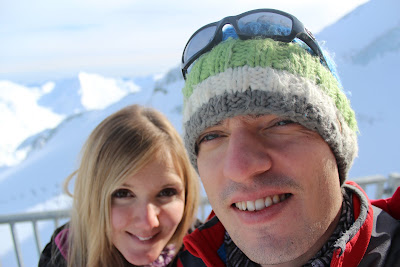Vals is at the end of the road from Ilanz - which navigates the slender Valser Tal and used to take 8 hours by horse and carriage. A quaint and virtually untouched mountain village, it has none of the glitz and glam of the more fashionable resorts like Zermatt or St Moritz. It has retained character and is home to scant restaurants and cafes; has a beautiful square where Tim and I befriend an alsation who enjoyed chasing ice balls; and yet is the location of one of Switzerland's most famous architectural gems: Therme Vals.
Designed by the award-winning Swiss architect Peter Zumthor, the mineral baths have an almost monastic style. The walls are high without interruption - ho hooks or railings - and constructed in Valser Quartzite, which is quarried locally and contributes to the flourishing local economy (tourism, water and stone). The stone is a melange of the most wonderful shades of dusky grey and muted purple. It creates a delicate contrast against the pale green water, which is illuminated from beneath.
With its high ceilings and narrow chambers - each hosting a different type of thermal pool - Therme Vals has magnificent acoustics, where sounds echo and create a chiming like bells from afar. There are none of the comforts that one may expect of modern-day 'wellness' like massage jets or seats in the pool. The hotel rooms named 'Temporaries', renovated by Peter Zumthor, are along a similar theme: stripped to the bare bones in an elegant black-and-white colour scheme that is like a cave for the twenty-first century.
There is no real distinction between the interior and the snowy winter wonderland outside, where the only punctuations in the white carpet are the frost pine trees. There is no TV, only a CD player and a collection of relaxing, classical CDs. It is not a place you should stay if you have any demons you are unwilling to cosy up with, for the effect of the room is quite like that of an Ashram. For me as a writer, however, it is heavenly. Breakfast in the hotel's Red Restaurant is superb with a great selection of local breads, cheeses and meats, as is dinner in Restaurant Chessi, where they serve hearty, traditional and regional meals.
During the other night of our visit, Tim and I dine in the Restaurant Edelweiss in the village, which is a cosy Stube with wood panelling and tasty food. One highlight of the weekend is a winter hike up past the valley lift station and beyond to the gorge - I love being out on foot in the snow; Tim would have preferred the ski lift to be open! I recommend Vals to those who just want to escape from it all for a couple of days, or those interested in architecture. It is a true wonder of Switzerland to which I cannot do justice in a blog post.
Designed by the award-winning Swiss architect Peter Zumthor, the mineral baths have an almost monastic style. The walls are high without interruption - ho hooks or railings - and constructed in Valser Quartzite, which is quarried locally and contributes to the flourishing local economy (tourism, water and stone). The stone is a melange of the most wonderful shades of dusky grey and muted purple. It creates a delicate contrast against the pale green water, which is illuminated from beneath.
With its high ceilings and narrow chambers - each hosting a different type of thermal pool - Therme Vals has magnificent acoustics, where sounds echo and create a chiming like bells from afar. There are none of the comforts that one may expect of modern-day 'wellness' like massage jets or seats in the pool. The hotel rooms named 'Temporaries', renovated by Peter Zumthor, are along a similar theme: stripped to the bare bones in an elegant black-and-white colour scheme that is like a cave for the twenty-first century.
There is no real distinction between the interior and the snowy winter wonderland outside, where the only punctuations in the white carpet are the frost pine trees. There is no TV, only a CD player and a collection of relaxing, classical CDs. It is not a place you should stay if you have any demons you are unwilling to cosy up with, for the effect of the room is quite like that of an Ashram. For me as a writer, however, it is heavenly. Breakfast in the hotel's Red Restaurant is superb with a great selection of local breads, cheeses and meats, as is dinner in Restaurant Chessi, where they serve hearty, traditional and regional meals.
During the other night of our visit, Tim and I dine in the Restaurant Edelweiss in the village, which is a cosy Stube with wood panelling and tasty food. One highlight of the weekend is a winter hike up past the valley lift station and beyond to the gorge - I love being out on foot in the snow; Tim would have preferred the ski lift to be open! I recommend Vals to those who just want to escape from it all for a couple of days, or those interested in architecture. It is a true wonder of Switzerland to which I cannot do justice in a blog post.


















































